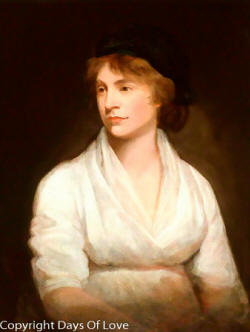

Queer Places:
375 Mare St, London E8, Regno Unito
Mary Wollstonecraft School, Matthias Rd, Mayville Estate, London N16 8NP, Regno Unito
45 Dolben St, London SE1 0UQ, Regno Unito
Rathbone Place, 26 Charlotte St, Fitzrovia, London W1T, Regno Unito
Cafe Deco, 43 Store St, Bloomsbury, London WC1E 7DB, Regno Unito
Oakshott Court, Werrington St, Kings Cross, London NW1, Regno Unito
Old St Pancras, Pancras Rd, London, Camden Town NW1 1UL, Regno Unito
St Peter, Bournemouth, Regno Unito
 Mary Wollstonecraft (27 April 1759 – 10 September 1797)
was the first woman First major work of feminist philosophy (Vindication of
the Rights of Woman) in 1792. In 1792, Mary Wollstonecraft published her
pioneering work, Vindication of
the Rights of Woman, demanding equal educational, employment and
political rights for women and an end to the sexual double standard.
Mary Wollstonecraft (27 April 1759 – 10 September 1797)
was the first woman First major work of feminist philosophy (Vindication of
the Rights of Woman) in 1792. In 1792, Mary Wollstonecraft published her
pioneering work, Vindication of
the Rights of Woman, demanding equal educational, employment and
political rights for women and an end to the sexual double standard.
She was an English writer, philosopher, and advocate of women's rights. During her brief career, she wrote novels, treatises, a travel narrative, a history of the French Revolution, a conduct book, and a children's book. Wollstonecraft is best known for A Vindication of the Rights of Woman (1792), in which she argues that women are not naturally inferior to men, but appear to be only because they lack education. She suggests that both men and women should be treated as rational beings and imagines a social order founded on reason. She had a romantic friendship with Fanny Blood.
Until the late 20th century, Wollstonecraft's life, which encompassed several unconventional personal relationships, received more attention than her writing. After two ill-fated affairs, with Henry Fuseli and Gilbert Imlay (by whom she had a daughter, Fanny Imlay), Wollstonecraft married the philosopher William Godwin, one of the forefathers of the anarchist movement. Wollstonecraft died at the age of 38, eleven days after giving birth to her second daughter, leaving behind several unfinished manuscripts. This daughter, Mary Wollstonecraft Godwin, became an accomplished writer herself, as Mary Shelley, whose best known work was Frankenstein.
After Wollstonecraft's death, her widower published a Memoir (1798) of her life, revealing her unorthodox lifestyle, which inadvertently destroyed her reputation for almost a century. However, with the emergence of the feminist movement at the turn of the twentieth century, Wollstonecraft's advocacy of women's equality and critiques of conventional femininity became increasingly important. Today Wollstonecraft is regarded as one of the founding feminist philosophers, and feminists often cite both her life and work as important influences.
Two friendships shaped Wollstonecraft's early life. The first was with Jane Arden in Beverley. The two frequently read books together and attended lectures presented by Arden's father, a self-styled philosopher and scientist. Wollstonecraft revelled in the intellectual atmosphere of the Arden household and valued her friendship with Arden greatly, sometimes to the point of being emotionally possessive. Wollstonecraft wrote to her: "I have formed romantic notions of friendship ... I am a little singular in my thoughts of love and friendship; I must have the first place or none."[5] In some of Wollstonecraft's letters to Arden, she reveals the volatile and depressive emotions that would haunt her throughout her life.[6] The second and more important friendship was with Fanny (Frances) Blood, introduced to Wollstonecraft by the Clares, a couple in Hoxton who became parental figures to her; Wollstonecraft credited Blood with opening her mind.[7]
Unhappy with her home life, Wollstonecraft struck out on her own in 1778 and accepted a job as a lady's companion to Sarah Dawson, a widow living in Bath. However, Wollstonecraft had trouble getting along with the irascible woman (an experience she drew on when describing the drawbacks of such a position in Thoughts on the Education of Daughters, 1787). In 1780 she returned home, called back to care for her dying mother.[8] Rather than return to Dawson's employ after the death of her mother, Wollstonecraft moved in with the Bloods. She realized during the two years she spent with the family that she had idealized Blood, who was more invested in traditional feminine values than was Wollstonecraft. But Wollstonecraft remained dedicated to her and her family throughout her life (she frequently gave pecuniary assistance to Blood's brother, for example).[9]
Wollstonecraft had envisioned living in a female utopia with Blood; they made plans to rent rooms together and support each other emotionally and financially, but this dream collapsed under economic realities. In order to make a living, Wollstonecraft, her sisters, and Blood set up a school together in Newington Green, a Dissenting community. Blood soon became engaged and after their marriage her husband, Hugh Skeys, took her to Lisbon, Portugal, to improve her health, which had always been precarious.[10] Despite the change of surroundings Blood's health further deteriorated when she became pregnant, and in 1785 Wollstonecraft left the school and followed Blood to nurse her, but to no avail.[11] Moreover, her abandonment of the school led to its failure.[12] Blood's death devastated Wollstonecraft and was part of the inspiration for her first novel, Mary: A Fiction (1788).[13]
My published books: